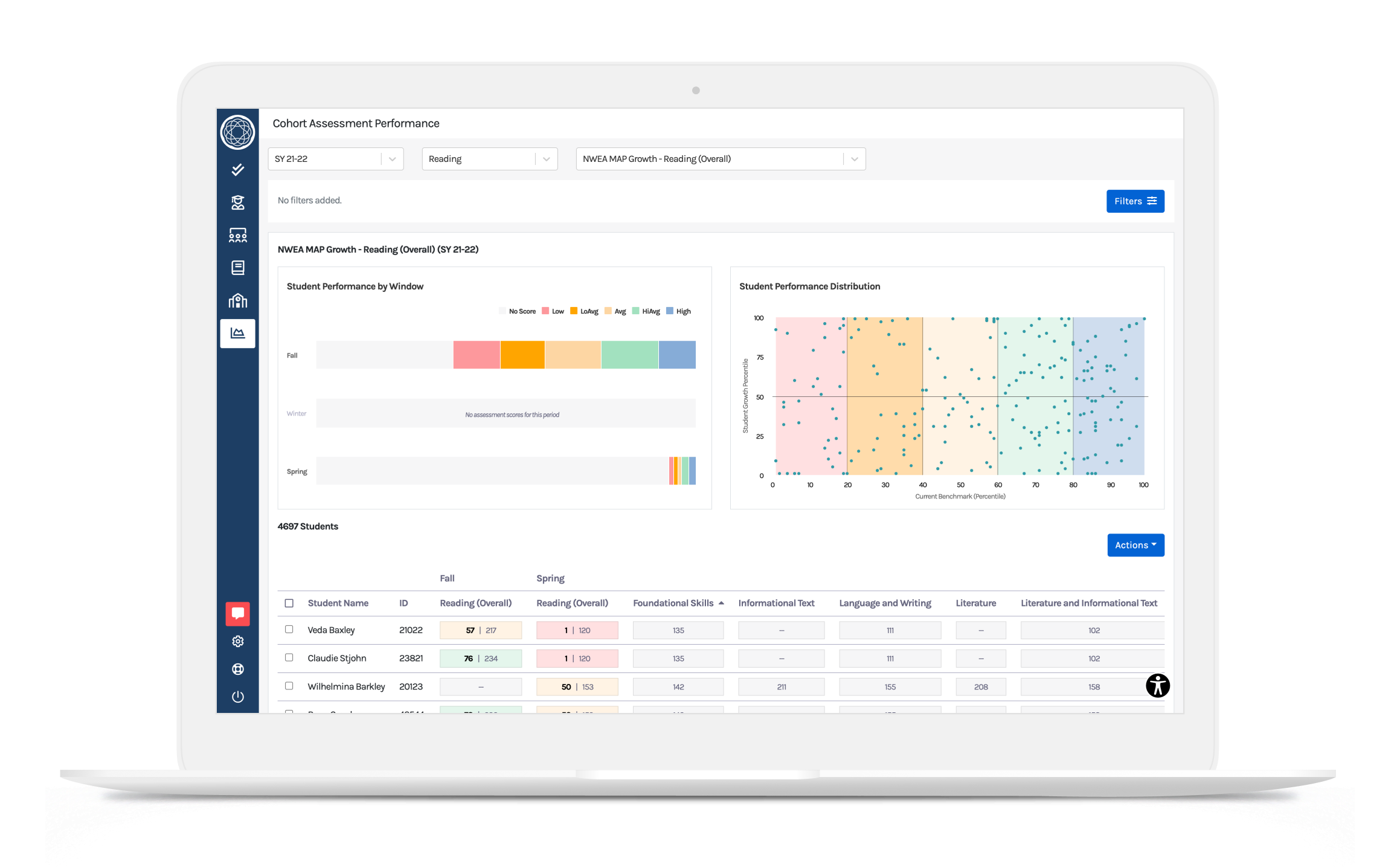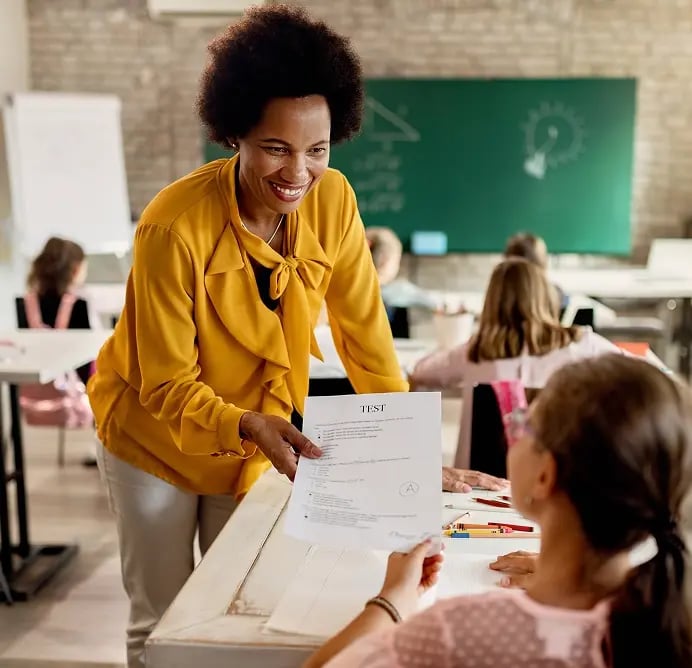One of the most effective ways to provide intervention for secondary students is through a school-wide WIN (What I Need) period. WIN is a scheduled but flexible time block where teachers provide targeted support and enrichment to students based on their individual needs. WIN time should be planned to include both intervention and enrichment.
Key Takeaways
- WIN Time provides a structure for successful secondary MTSS intervention and enrichment.
- Dynamic student grouping allows adjustments based on real-time progress.
- Teacher collaboration and student goal-setting help drive success.
When launching a school-wide or district-wide initiative like WIN time, several legitimate concerns arise:
- How do we schedule the time with all the competing priorities?
- What should teachers do with the time?
- How do we ensure dynamic groups allow students to move in and out as needed?
- How do we support teachers in effectively implementing interventions?
How to Schedule WIN Time in Secondary MTSS Interventions
Scheduling at the secondary level is always a challenge! Ensure the right people are involved in decision-making so that all competing priorities are considered.
A successful secondary MTSS schedule includes:
- Adequate time, space, staffing, and resources for intervention/enrichment to meet the needs of all students
- Flexibility for students to move in and out of Tier 2 and Tier 3 interventions as data indicates
Secondary School WIN Time Schedules
WIN Block Schedule
| Block 1 | 80 minutes |
| Block 2 | 80 minutes |
| Lunch/WIN | Lunch/WIN 25 minutes Lunch/WIN 25 minutes Students rotate |
| Block 3 | 80 minutes |
| Block 4 | 80 minutes |
Numerous other iterations include a floating/rotating block schedule, a hybrid block, or an encore period schedule.
WIN Singleton Schedule
| Period 1 | 50 minutes |
| Period 2 | 50 minutes |
| Period 3 | 50 minutes |
| Period 4 | 50 minutes |
| POWER HOUR | 55 minutes Lunch or WIN 25 minutes 5 min passing Lunch or WIN 25 minutes |
| Period 5 | 50 minutes |
| Period 6 | 50 minutes |
| Period 7 | 50 minutes |
How to Utilize WIN Time
WIN time can include:
- Support for Tier 1: Reteach key concepts from a recent lesson to ensure all students solidify their understanding before moving on to new material. You can also preteach concepts to students who may struggle to grasp them the first time.
- Enrichment opportunities: Some schools have clubs that meet during this time. For example, students who excel in math could participate in a robotics workshop where they design and program robots, enhancing critical thinking and engineering skills.
- Tier 2 targeted intervention groups that address specific skill gaps: For example, you may have students struggling with fractions receive focused instruction using hands-on activities to improve their understanding and application of fraction concepts.
- Tier 3 intensive support for students with significant learning gaps: A student who reads below grade level works one-on-one with a reading specialist to improve phonics, fluency, and comprehension skills using a structured literacy program. The classroom teacher can also work with this student to break down important concepts and provide small text and learning to help the student apply reading skills to content.
To ensure alignment:
- Create a curriculum map for the year with key standards identified for each quarter.
- Utilize cross-disciplinary planning to allow collaboration between teachers across the support offered.
- Identify and utilize assessment data. More extensive, more formal assessments like state tests can give a foundation for thinking through the needed supports.
- Use ongoing formative assessment to identify student learning gaps. This information can be applied immediately in WIN time.
- Consider core competencies. If teachers collaborate and discover an underlying skill issue, like comprehension, support can be provided to strengthen these skills across all areas.
Regardless of the schedule option, here are common strategies used during WIN time.
Small Group Instruction
Small groups should be formed by bringing together students with similar learning gaps.
If teachers have larger groups during WIN time, instructional tasks that students can complete with a partner or independently can be offered. The teacher can then pull small groups and work with them, while other students practice the needed skills.

Have your students help set their goals and create a work plan. Students who identify their goals are more likely to be engaged during learning time.
Peer Tutoring in Secondary Schools
Having students support one another in their learning is a proven way to increase achievement. If you have taken the time to help students set up goals and work plans, they can use these as a guide for their peer learning time.
➡️ Dig Deeper: Five Peer Tutoring Strategies for the Classroom
One-On-One Support
Some students may need more intensive support. WIN time is ideal for providing individual support. Because the time is focused and intense, you can allot less time than when working with a small group.
For example, a 9th grader I taught struggled with basic reading skills and had trouble regulating his behavior. A small group setting would often set him off because he didn’t want others to know he struggled. At the start of each day, I realigned my 30 minutes of small group time to work with him for 7 minutes individually. I introduced a new concept (i.e., a new spelling pattern, a chunk of text for fluency, writing complete sentences, etc.), and we practiced it. Then, I helped him plan for his individual practice time. This still gave me 20 minutes to rotate two small groups each day.
How to Maximize Resources During WIN Time
Just as there is no way to schedule WIN, there is no way to utilize resources during WIN. Remember, how we plan our time represents what we prioritize. If we want all students to have access to meaningful instruction during WIN time, we must be willing to organize and make the most of all available resources.
Draw on Your Staff's Strengths
WIN time in many schools takes an "all hands on deck" approach. School leadership, support staff, and teachers all work together to create learning opportunities for every student.
Several schools I have worked in have utilized this strategy. The background and strengths of each adult are considered when planning which staff will handle which WIN group.
- Certified teachers who are experts in their content should work with groups needing intensive support.
- Support staff can be trained to work effectively with students needing enrichment or strategic support.
Professional Learning for Teachers
Creating an ongoing professional development plan is critical so that staff have opportunities explicitly focused on effective intervention strategies and the successful implementation of WIN time.
When considering what professional development to provide for teachers, some key areas to focus on are:
- Differentiated instruction - practical strategies for small group instruction
- Using data to create groups
- Using data to realign instruction
- Formative assessment and progress monitoring
Your professional development plan should also provide time for staff feedback, which will guide any adjustments needed. Progress monitoring isn’t just for our students!
Collaborative Planning Time
If I had to advocate for one non-negotiable, collaborative planning time would be protected! Planning periods are critical to the success of WIN time and teacher buy-in. This time allows staff to:
- Design WIN time activities
- Share insights and ideas
- Reflect on student progress
- Address challenges
Teacher collaboration is at the heart of MTSS. It enhances collective efficacy and encourages shared ownership of student outcomes.
➡️ Dig Deeper: Practical Ways to Address Educator Workload and Help Teachers Thrive, with Angela Watson
If we set up WIN groups once at the beginning of the year and never change them, students may be sitting in learning spaces that aren't offering them what they truly need!
|
WIN Time, Secondary Intervention Time Resources Bunner, Teresa. “Master Scheduling for MTSS: Options and Challenges.” Branching Minds. Bunner, Teresa. “The Importance of Engaging Student Voice in MTSS.” Branching Minds, https://www.branchingminds.com/blog/engaging-student-voices-mtss. Accessed 1 Jan. 2025 Durrance, S. (2023). Implementing MTSS in Secondary Schools: Challenges and Strategies. Greensboro, NC: SERVE Center at UNC Greensboro. Massachusetts Department of Elementary and Secondary Education. MTSS Resource: Sample Student Schedules. Malden, MA: Massachusetts Department of Elementary and Secondary Education. https://ese-resources-clearinghouse.squarespace.com/s/Sample-Student-Schedules.docx |
![[Guest Author] Teresa Bunner-avatar](https://www.branchingminds.com/hs-fs/hubfs/Imported_Blog_Media/Teresa%20Bunner%20headshot-1.png?width=82&height=82&name=Teresa%20Bunner%20headshot-1.png)
About the author
[Guest Author] Teresa Bunner
Teresa is an Educational Consultant with Branching Minds. She has had the privilege in her 30 year public education career to serve in a variety of roles where she has honed her skills as a classroom practitioner, coach and education leader. She served for over 20 years as a classroom teacher teaching almost every grade from 1st- 12th. At the school level and district level, Teresa held roles as a literacy coach, instructional coach, program academic specialist, district coordinating teacher for secondary literacy and the Director for Student Engagement in the Office of Equity Affairs in the largest school district in North Carolina. All of Teresa’s experiences have helped her gain expertise in working with students and families to co-create teaching and learning spaces and experiences that center and affirm our students’ and families’ cultural heritages as assets. Teresa is also a mom and is pretty proud of the four amazing human beings she raised. You’ll often find her hanging out with them talking books, social issues and (currently) cheering on her youngest as a college swimmer.

MTSS Professional Learning
Deepen educator practice and strengthen your infrastructure to sustain MTSS through onsite and remote professional development options.













.png?width=1436&height=956&name=MTSS-interventions-secondary-school(preview).png)



.png?width=716&height=522&name=Tech-Learning-Most-Influential-Edtech-Product-2025(preview).png)